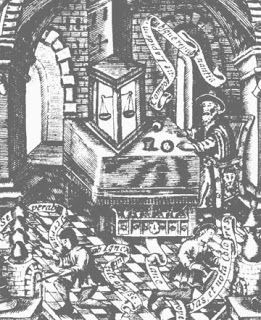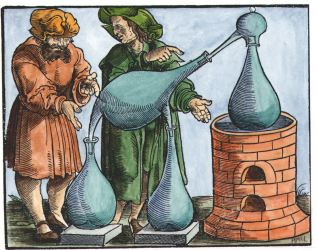| Author | Post |
|---|
Alexander Guthrie Stewart
Member
| Joined: | Sat Feb 16th, 2008 |
| Location: | |
| Posts: | 192 |
| Status: |
Offline
|
|
Posted: Mon Nov 19th, 2012 05:24 pm |
|
I recently found some surviving medieval/ post medieval chests which reminded me of the one in the famous illustration of Thomas Norton and the scientific balance.
This led to my studying the illustrations more closely, and I reckon that Newman and Principe's understanding of much of the illustration is wrong. (as written in "Alchemy tried in the fire")
But to build a better alternative hypothesis, I tried to read the text that is around the people in the picture. That turned out to be a bit hard - has anyone seen a transcription of the words in the picture? Or any of the other pictures?
My transcription is as follows, based on the picture in the EETS edition is:
Original 15th century illustrations
Norton at the table with the balance, he says - "Compode lapidem ah???repugnanoa"
Left operator - "squearins tra ab igne subtile alpillo"
right operator - "mane prope vas nota colores"
Looking at Ashmoles Theatrum Chemicum Britannicum I find:
Book being handed to kneeling man. Knealing man says "Secreta Alkymiae secrete servabo?"
Seated man says "Accipe donum Dei sub??igillo? Sacrato"
Above them the angel on left has "Dis? Ivshtia?" lots of words then "preparaticibus tues"
One on right has "Expectn Dominum veriliter age, et confortet cor tuum"
Illustration with old alchemists
Geber - "tere tere, tere, iterum tere, nec te tedeat"
Arnoldus - Bibat quantum ???ote?t ??sque ?hiodeci??
Rases - Quotties corpus imbibitur totties de siccatur"
Hermes - "Hoc uigniub ? ies afsa ? et coquite donec facie ? seyu? germinare"
Illustration with balance, sun, moon and crucible or suchlike.
Man at table - "Compa?e lapidem ??? repat??/ nantia"
left hand operator - "Se perabi? Terram ab Ignem ???? aspiso?"
right hand operator - "Mane prope vas, et nom colores"
|
Paul Ferguson
Member

| Joined: | Fri Feb 15th, 2008 |
| Location: | |
| Posts: | 1538 |
| Status: |
Offline
|
|
Posted: Mon Nov 19th, 2012 06:30 pm |
|
Alexander Guthrie Stewart wrote:
I recently found some surviving medieval/ post medieval chests which reminded me of the one in the famous illustration of Thomas Norton and the scientific balance.
This led to my studying the illustrations more closely, and I reckon that Newman and Principe's understanding of much of the illustration is wrong. (as written in "Alchemy tried in the fire")
But to build a better alternative hypothesis, I tried to read the text that is around the people in the picture. That turned out to be a bit hard - has anyone seen a transcription of the words in the picture? Or any of the other pictures?
My transcription is as follows, based on the picture in the EETS edition is:
Original 15th century illustrations
Norton at the table with the balance, he says - "Compode lapidem ah???repugnanoa"
Left operator - "squearins tra ab igne subtile alpillo"
right operator - "mane prope vas nota colores"
The Norton seems to read:
Compone lapidem absque repugnantia = Compose the stone without repugnance.
Separabis terram ab igne, subtile ab spisso = You shall separate the earth from the fire, the subtle from the gross (this text is taken from the Emerald Tablet).
Mane prope vas et nota colores = Remain near to the vase and note the colours.
Ashmole:
Top left is Psalms 44.8 =
Dilexisti iustitiam et odisti iniquitatem propterea unxit te Deus Deus tuus oleo laetitiae prae particibus tuis = Thou hast loved justice, and hated iniquity: therefore God, thy God, hath anointed thee with the oil of gladness above thy fellows.
Top right:
Again from the Psalms:
Expecta Dominum, viriliter age : et confortetur cor tuum, et sustine Dominum (Psalms 27.14) = Expect the Lord, do manfully, and let your heart take courage, and wait for the Lord.
Bottom left:
Secreta Alkymiae secrete servabo = I shall keep secret the secrets of Alchemy.
Bottom right:
Accipe donum Dei sub sigillo sacrato = Accept the gift of God under the sacred seal.
Last edited on Mon Nov 19th, 2012 07:14 pm by Paul Ferguson
|
Alexander Guthrie Stewart
Member
| Joined: | Sat Feb 16th, 2008 |
| Location: | |
| Posts: | 192 |
| Status: |
Offline
|
|
Posted: Mon Nov 19th, 2012 08:17 pm |
|
Thank you. I still need lots more practise in reading the scripts.
That doesn't completely sort out my hypothesis, but is interesting and somewhat relevant nonetheless. Not that I've got any earthshaking ideas, rather some clarification of the image and it's meanings.
|
Paul Ferguson
Member

| Joined: | Fri Feb 15th, 2008 |
| Location: | |
| Posts: | 1538 |
| Status: |
Offline
|
|
Posted: Tue Nov 20th, 2012 01:38 am |
|
Hi Alexander,
My experience of these scroll-legends is that they are usually neither original nor particularly legible. The best one can do is usually decipher a run of, say, three words and put them into a Google search with quotes around them. This usually pulls up the original text, as here with quotations from the Emerald Tablet and the Psalms.
Do you know this book by Holmes?
http://books.google.com/books?id=gdLk3YPZiLEC&pg=PA40&lpg=PA40&dq=%22ms+additional+10302%22&source=bl&ots=3EET7xKkBG&sig=Zv88P85aH9dMrwvfdheOXLfs-S4&hl=fr&sa=X&ei=rN6qULPpLaSe0QWD2oH4DQ&ved=0CCgQ6AEwAQ#v=onepage&q=%22ms%20additional%2010302%22&f=false
|
Alexander Guthrie Stewart
Member
| Joined: | Sat Feb 16th, 2008 |
| Location: | |
| Posts: | 192 |
| Status: |
Offline
|
|
Posted: Tue Nov 20th, 2012 10:22 am |
|
Yes thank you, although I couldn't remember it just now.
I suggest that examination of the 15th century picture shows not a monk in the middle of the 4 crucibles in the trunk, but something like a covered chalice, and the crucibles contain the four elements. Not only is it a completely different proportion to the other items in the crucible, but the shape is wrong as well. The colour, well, if it was a mould a bronze-ish yellow colour would be acceptable, but since it has survived so well I wonder what the pigment is. If it is gold leaf, I refuse to believe that it would have been used for a mould for crucibles.
Even worse, when you look at Newman's claim in that paper that it is the monk or plunger that is to be driven into the clay to make the crucible, he has gone far wrong, although on google books I can't see figure 2.3 to see what he is referring to.
I know a bit about crucibles. The many that have been found in archaeological excavations often do not have any clear sign of the means of manufacture. However Biringuccio mentions making crucibles on a wheel, and I know from experience that a good potter can produce a crucible in a few minutes on a potters wheel. Theophilus, writing 4 centuries earlier than Biringuccio, shaped his crucibles by hand on a piece of wood. Therefore this crucible mould idea is almost certainly false. Perhaps he has been led astray by the subtly different Theatrum Chemicum Britannicum reproduction of the illustration, or the 17th century work he has done, or maybe he does know of some information about crucible manufacture that I have not come across before, but I doubt it.
Instead, what it looks like is this, the Lacock Chalice, a 14th century covered cup:

Back to the crucibles - if they are the four elements, I might expect them to all have different colours within, which would require a good look or some proper analysis. The presence of blue suggests that they aren't the alchemical black white yellow red sequence, whereas blue could be water, red could be fire, but I'm not yet sure what earth and air would be. If they were the four elements, the middle one might be the quintessence, which Norton made, although his alchemy was based on the four elements. Or maybe it is an elixir, in an appropriately important looking cup?
The final difference is the third item on the table beside the sun and moon. Newman thinks that is a cupel, spuming litharge. I can see why he thinks that, especially if you look at the 17th century Theatrum Chemicum Britannicum illustration. But in this case, looking at the EETS illustration it is clear that it cannot be such a thing, because the 'spume' is coming from part way down and it looks like it has a lid. Cupels don't have lids, although the proportions aren't too far wrong. Instead it looks more like a container holding something, with a lid of cloth impregnated with wax and tied around the top like jam jars used to be. Maybe it contains the stone?
|
Paul Ferguson
Member

| Joined: | Fri Feb 15th, 2008 |
| Location: | |
| Posts: | 1538 |
| Status: |
Offline
|
|
Posted: Tue Nov 20th, 2012 01:42 pm |
|
Visual aids here:
http://tinyurl.com/d3zjhcr
Ferguson 191:
http://special.lib.gla.ac.uk/exhibns/treasures/alchemy2.html
Compare with the illustration from Basil Valentine: Révélation des mystères des teintures essentielles des sept métaux (see below).
Is that the symbol for Gemini on the front-face of the chest or am I imagining things?Attached Image (viewed 1131 times):
 Last edited on Wed Nov 21st, 2012 01:04 pm by Paul Ferguson
|
Alexander Guthrie Stewart
Member
| Joined: | Sat Feb 16th, 2008 |
| Location: | |
| Posts: | 192 |
| Status: |
Offline
|
|
Posted: Tue Nov 20th, 2012 02:37 pm |
|
| It looks more like a standard medieval chest lock, with the round hole for the key and the vertical slot for the hasp or whatever you call it.
|

Current time is 09:40 am | |
|
|
|

